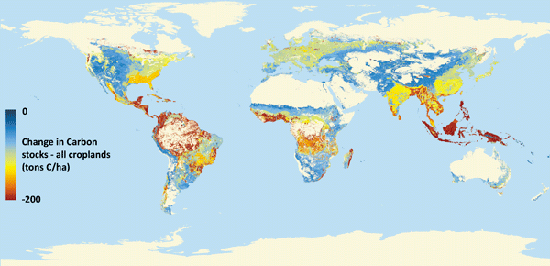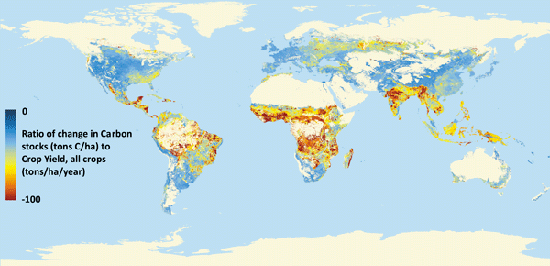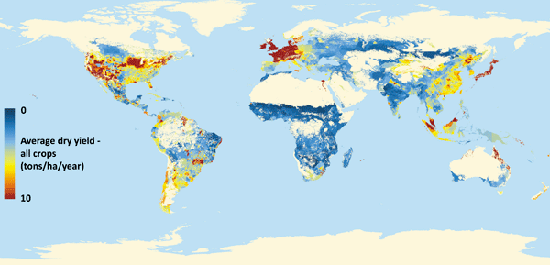Expanding croplands chipping away at world’s carbon stocks
Nature’s capacity to store carbon, the element at the heart of global climate woes, is steadily eroding as the world’s farmers expand croplands at the expense of native ecosystem such as forests.
The tradeoff between agricultural production and maintaining nature’s carbon reservoirs — native trees, plants and their carbon-rich detritus in the soil — is becoming more pronounced as more and more of the world’s natural ecosystems succumb to the plow. The problem, experts say, is most acute in the tropics, where expanding agriculture often comes at the expense of the tropical forests that act as massive carbon sinks because of their rich diversity and abundance of plant life.
The seriousness of the problem is documented in the most comprehensive and fine-grained analysis of the world’s existing carbon stocks and global crop yields. The study is published online this week (Nov. 1) in the Proceedings of the National Academy of Sciences (PNAS) by a team of researchers from the University of Wisconsin–Madison, the University of Minnesota, Stanford University, Arizona State University and The Nature Conservancy. The article is part of a special PNAS feature on climate mitigation and agricultural productivity in the tropics.
“We analyzed the tradeoffs between carbon storage and crop production at a level of detail that has never been possible before,” according to Stephen Carpenter, one of the senior authors of the study and a professor at the Center for Limnology at UW–Madison. “The main news is that agricultural production by clearing land in the tropics releases a lot of greenhouse gases per unit of food produced.”
Compared to the world’s temperate regions, the tropics release nearly twice as much carbon to the atmosphere for each unit of land cleared, explains Paul C. West, a UW–Madison graduate student and the lead author of the new study. “Tropical forests store a tremendous amount of carbon, and when a forest is cleared, not only do you lose more carbon, but crop yields are not nearly as high as they are in temperate areas.”
“This creates a kind of ‘double whammy’ for a lot of tropical agriculture: we have to clear carbon-rich ecosystems to create tropical croplands, and unfortunately they often have lower yields than temperate systems,” says Jonathan Foley, director of the University of Minnesota’s Institute on the Environment and a co-author on the study. “In terms of balancing the needs of food production and slowing carbon dioxide emissions, this is a tough tradeoff.”
In the tropics, for example, it is estimated that for every ton of crop yield, carbon stocks are diminished by as much as 75 tons. Such attrition, say West and his colleagues, makes a strong case for intensifying agriculture on already-converted land instead of putting new fields into production.
“One path is to expand agricultural land,” says West. “The other path is to intensify agriculture on existing lands. The realty is there will be some of both.”
Today, about 20 percent of the land in temperate regions is in cropland. In the tropics, 11 percent of the land is farmed. However, in the tropics pressure to plant more land is growing fastest due to increasing human population, changing diets, food security concerns, and a rising demand for the raw materials of biofuels.
Carbon is one of the planet’s most abundant elements. It is present in all known life forms and moves naturally between the biosphere, oceans and atmosphere in a process that allows the element to be continuously recycled. Human processes, and in particular agriculture, accelerate the process by rapidly converting carbon stocks in trees, other plants and the soil to carbon dioxide, the primary greenhouse gas.
Global carbon stocks, notes West, can be analogous to a checking account: “The math is pretty simple. When you clear a forest, it is like making a big withdrawal from the checking account.”
The new study utilized a combination of satellite data and government reports to determine the extent of cultivation for 175 different crop plants worldwide. Estimates of global carbon stocks in natural vegetation, obtained from a recent Intergovernmental Panel on Climate Change (IPCC) report, were based on field measurements and averaged according to vegetation type, climate and continent. The data were then used to quantify and map the tradeoff between carbon stocks and crop production globally on a grid at a resolution of 10 kilometers by 10 kilometers.
“We have a very fine resolution of both what the carbon stocks and the yields are globally,” says West. “Spatially, it is much more explicit than anything that has been produced before.”
The result, explains the Wisconsin researcher, is a set of “paint by numbers maps” showing global cropland distribution and yields, and changes in carbon stock due to cropland conversion.
Carpenter, West and Foley believe the new analysis will be a valuable tool for governments, nonprofit organizations and businesses. Already, commercial carbon exchanges are beginning to emerge and detailed knowledge of where carbon stocks are preserved or could be expanded will be valuable information.
In addition to West, Carpenter and Foley, authors of the new study include Holly K. Gibbs of Stanford University, Chad Monfreda of Arizona State University, John Wagner of the Nature Conservancy, and Carol Barford of UW–Madison. NASA, The Nature Conservancy and the U.S. Department of Energy funded the study.
Carbon Cycle Maps
Global cropland distribution and average annual yields between 1998 and 2002. Highest crop yields are in temperate regions of Western Europe and North America.

Changes in carbon stocks due to cropland conversion. Loss of forests and other native ecosystems is steadily eroding the world’s natural carbon reservoirs, according to 2007 data collected by the International Panel on Climate Change. The problem is greatest in the tropics, as native tropical ecosystems tend to store more carbon.

Combining global cropland distribution and changes in carbon stocks due to cropland expansion into native ecosystems shows that carbon loss per ton of annual crop yield is nearly three times as high in the tropics compared to temperate regions.
Maps: courtesy Paul West, UW–Madison Center for Sustainability and the Global Environment and UW–Madison Center for Limnology





